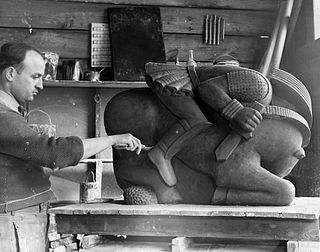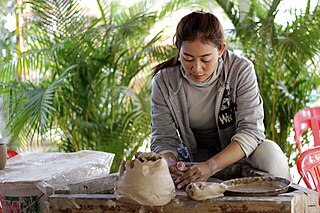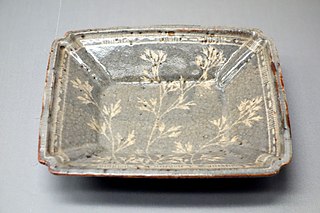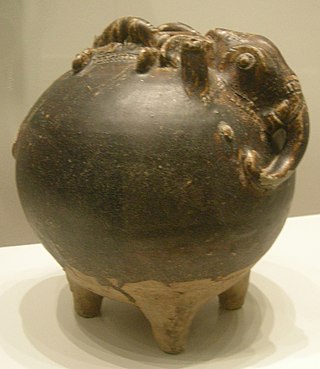The New York State College of Ceramics at Alfred University (NYSCC) is a statutory college of the State University of New York located on the campus of Alfred University, Alfred, New York. There are a total of 616 students, including 536 undergraduates and 80 graduates.

Hard-paste porcelain, sometimes called "true porcelain", is a ceramic material that was originally made from a compound of the feldspathic rock petuntse and kaolin fired at a very high temperature, usually around 1400 °C. It was first made in China around the 7th or 8th century and has remained the most common type of Chinese porcelain.

Buncheong (Korean: 분청), or punch'ong, ware is a traditional form of Korean stoneware, with a blue-green tone. Pieces are coated with white slip (ceramics), and decorative designs are added using a variety of techniques. This style originated in the 15th century and continues in a revived form today.

Studio pottery is pottery made by professional and amateur artists or artisans working alone or in small groups, making unique items or short runs. Typically, all stages of manufacture are carried out by the artists themselves. Studio pottery includes functional wares such as tableware and cookware, and non-functional wares such as sculpture, with vases and bowls covering the middle ground, often being used only for display. Studio potters can be referred to as ceramic artists, ceramists, ceramicists or as an artist who uses clay as a medium.

Agano ware is a type of Japanese pottery traditionally made in Fukuchi, Tagawa District, Fukuoka.

Haji pottery is a type of plain, unglazed, reddish-brown Japanese pottery or earthenware that was produced during the Kofun, Nara, and Heian periods of Japanese history. It was used for both ritual and utilitarian purposes, and many examples have been found in Japanese tombs, where they form part of the basis of dating archaeological sites.
Diana Pancioli Kulisek, born in Detroit, Michigan, is professor of ceramics at Eastern Michigan University and the author of Extruded Ceramics published in 1999 by Sterling Publishing Co., Inc. She is a former head of Production at Pewabic Pottery in Detroit. Among her artistic works are the ceramic arches at the People Mover Cadillac Center Station in Detroit.

Waylande Desantis Gregory was one of the most innovative and prolific American art-deco ceramics sculptors of the early 20th century. His groundbreaking techniques enabled him to create monumental ceramic sculpture, such as the Fountain of the Atoms and Light Dispelling Darkness, which had hitherto not been possible. He also developed revolutionary glazing and processing methods, and was a seminal figure in the studio glass movement.
Frank Wilfred Vining was an influential teacher of pottery who founded and, for over thirty years, led the ceramics course at Cardiff College of Art.

A ceramics museum is a museum wholly or largely devoted to ceramics, usually ceramic art. Its collections may also include glass and enamel, but typically concentrate on pottery, including porcelain. Most national collections are in a more general museum covering all of the arts, or just the decorative arts. However, there are a number of specialized ceramics museums, with some focusing on the ceramics of just one country, region or manufacturer. Others have international collections, which may be centered on ceramics from Europe or East Asia or have a more global emphasis.
Klytie Pate was an Australian studio potter who emerged as an innovator in the use of unusual glazes and the extensive incising, piercing and ornamentation of earthenware pottery. She was one of a small group of Melbourne art potters which included Marguerite Mahood and Reg Preston who were pioneers in the 1930s of ceramic art nationwide. Her early work was strongly influenced by her aunt, the artist and printmaker, Christian Waller.

Thai ceramics are ceramic art and pottery designed or produced as a form of Thai art. The tradition of Thai ceramics dates back to the third millennium BCE. Much of Thai pottery and ceramics in the later centuries was influenced by Chinese ceramics, but has always remained distinct by mixing indigenous styles with preferences for unique shapes, colors and decorative motifs. Thai pottery and ceramics were an essential part of the trade between Thailand and its neighbors during feudalistic times, throughout many dynasties.

The Khmer Ceramics & Fine Arts Centre, formerly known as the National Centre for Khmer Ceramics Revival (NCKCR), is an organization aiming to rediscover and reintroduce Khmer ancestral pottery techniques and support the development of contemporary Khmer ceramics art. In the process, the centre creates economic opportunities, helping to decrease poverty in Cambodia. It is located in Siem Reap.

Ceramic art is art made from ceramic materials, including clay. It may take varied forms, including artistic pottery, including tableware, tiles, figurines and other sculpture. As one of the plastic arts, ceramic art is a visual art. While some ceramics are considered fine art, such as pottery or sculpture, most are considered to be decorative, industrial or applied art objects. Ceramic art can be created by one person or by a group, in a pottery or a ceramic factory with a group designing and manufacturing the artware.

Mino ware is a style of Japanese pottery, stoneware, and ceramics that is produced in Mino Province, mainly in the cities of Tajimi, Toki, Mizunami, and Kani in Gifu Prefecture, central Japan.

Shōdai ware is a type of Japanese pottery traditionally from Arao, Kumamoto.

Tsuboya ware is a type of Ryukyuan pottery traditionally produced in Tsuboya, a pottery district in the city of Naha, in the prefecture Okinawa. Okinawan craftsmen began engaging in this form of pottery in 1682, and have since passed down the craft for generations. The most notable feature of this ware is its enamel decoration, unique to Okinawa. Originally, ceramics produced in this style were used primarily by common, middle-class people. However, during the Taisho period (1912-1926), the style was popularized by folk art proponents like Muneyoshi Yanagi. Tsuboya ware is categorized into two types: arayachi and jouyachi. While arayachi is a more simple style and takes the form of vessels for water or alcohol, jouyachi can be recognized by its rich enamel decoration.
The conservation and restoration of ancient Greek pottery is a sub-section of the broader topic of conservation and restoration of ceramic objects. Ancient Greek pottery is one of the most commonly found types of artifacts from the ancient Greek world. The information learned from vase paintings forms the foundation of modern knowledge of ancient Greek art and culture. Most ancient Greek pottery is terracotta, a type of earthenware ceramic, dating from the 11th century BCE through the 1st century CE. The objects are usually excavated from archaeological sites in broken pieces, or shards, and then reassembled. Some have been discovered intact in tombs. Professional conservator-restorers, often in collaboration with curators and conservation scientists, undertake the conservation-restoration of ancient Greek pottery.

Khmer ceramics refers to ceramic art and pottery designed or produced as a form of Khmer art. The tradition of Cambodian ceramics dates back to the third millennium BCE. Pottery and ceramics were an essential part of the trade between Cambodia and its neighbours.

Neil Macalister Grant was a New Zealand potter and ceramics teacher.
















